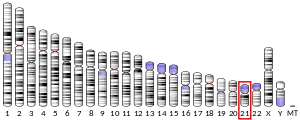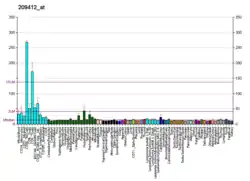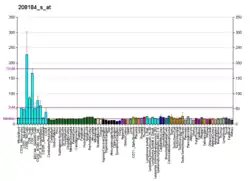| TRAPPC10 | |||||||||||||||||||||||||||||||||||||||||||||||||||
|---|---|---|---|---|---|---|---|---|---|---|---|---|---|---|---|---|---|---|---|---|---|---|---|---|---|---|---|---|---|---|---|---|---|---|---|---|---|---|---|---|---|---|---|---|---|---|---|---|---|---|---|
| Identifiers | |||||||||||||||||||||||||||||||||||||||||||||||||||
| Aliases | TRAPPC10, EHOC-1, EHOC1, GT334, TMEM1, TRS130, TRS30, trafficking protein particle complex 10, trafficking protein particle complex subunit 10 | ||||||||||||||||||||||||||||||||||||||||||||||||||
| External IDs | OMIM: 602103 MGI: 1336209 HomoloGene: 37751 GeneCards: TRAPPC10 | ||||||||||||||||||||||||||||||||||||||||||||||||||
| |||||||||||||||||||||||||||||||||||||||||||||||||||
| |||||||||||||||||||||||||||||||||||||||||||||||||||
| |||||||||||||||||||||||||||||||||||||||||||||||||||
| |||||||||||||||||||||||||||||||||||||||||||||||||||
| Wikidata | |||||||||||||||||||||||||||||||||||||||||||||||||||
| |||||||||||||||||||||||||||||||||||||||||||||||||||
Trafficking protein particle complex subunit 10 is a protein that in humans is encoded by the TRAPPC10 gene.[4][5]
The protein encoded by this gene is a transmembrane protein found in the cis-Golgi complex. The encoded protein is part of the multisubunit transport protein particle (TRAPP) complex and may be involved in vesicular transport from the endoplasmic reticulum to the Golgi.
Mutations in this gene could be responsible for the Unverricht-Lundborg type of progressive myoclonus epilepsy, or for autoimmune polyglandular disease type 1. Two transcript variants encoding different isoforms have been found for this gene.[5]
References
- 1 2 3 GRCh38: Ensembl release 89: ENSG00000160218 - Ensembl, May 2017
- ↑ "Human PubMed Reference:". National Center for Biotechnology Information, U.S. National Library of Medicine.
- ↑ "Mouse PubMed Reference:". National Center for Biotechnology Information, U.S. National Library of Medicine.
- ↑ Yamakawa K, Mitchell S, Hubert R, Chen XN, Colbern S, Huo YK, Gadomski C, Kim UJ, Korenberg JR (Sep 1995). "Isolation and characterization of a candidate gene for progressive myoclonus epilepsy on 21q22.3". Hum Mol Genet. 4 (4): 709–16. doi:10.1093/hmg/4.4.709. PMID 7633421.
- 1 2 "Entrez Gene: TMEM1 transmembrane protein 1".
Further reading
- Nagamine K, Kudoh J, Minoshima S, et al. (1996). "Isolation of cDNA for a novel human protein KNP-I that is homologous to the E. coli SCRP-27A protein from the autoimmune polyglandular disease type I (APECED) region of chromosome 21q22.3". Biochem. Biophys. Res. Commun. 225 (2): 608–16. doi:10.1006/bbrc.1996.1218. PMID 8753807.
- Bonaldo MF, Lennon G, Soares MB (1997). "Normalization and subtraction: two approaches to facilitate gene discovery". Genome Res. 6 (9): 791–806. doi:10.1101/gr.6.9.791. PMID 8889548.
- Nagamine K, Kudoh J, Kawasaki K, et al. (1997). "Genomic organization and complete nucleotide sequence of the TMEM1 gene on human chromosome 21q22.3". Biochem. Biophys. Res. Commun. 235 (1): 185–90. doi:10.1006/bbrc.1997.6758. PMID 9196060.
- Nagamine K, Kudoh J, Minoshima S, et al. (1997). "Genomic organization and complete nucleotide sequence of the human PWP2 gene on chromosome 21". Genomics. 42 (3): 528–31. doi:10.1006/geno.1997.4761. PMID 9205129.
- Lafrenière RG, Kibar Z, Rochefort DL, et al. (1997). "Genomic structure of the human GT334 (EHOC-1) gene mapping to 21q22.3". Gene. 198 (1–2): 313–21. doi:10.1016/S0378-1119(97)00333-8. PMID 9370297.
- Hattori M, Fujiyama A, Taylor TD, et al. (2000). "The DNA sequence of human chromosome 21". Nature. 405 (6784): 311–9. Bibcode:2000Natur.405..311H. doi:10.1038/35012518. PMID 10830953.
- Gavin AC, Bösche M, Krause R, et al. (2002). "Functional organization of the yeast proteome by systematic analysis of protein complexes". Nature. 415 (6868): 141–7. Bibcode:2002Natur.415..141G. doi:10.1038/415141a. PMID 11805826. S2CID 4425555.
- Strausberg RL, Feingold EA, Grouse LH, et al. (2003). "Generation and initial analysis of more than 15,000 full-length human and mouse cDNA sequences". Proc. Natl. Acad. Sci. U.S.A. 99 (26): 16899–903. Bibcode:2002PNAS...9916899M. doi:10.1073/pnas.242603899. PMC 139241. PMID 12477932.
- Ota T, Suzuki Y, Nishikawa T, et al. (2004). "Complete sequencing and characterization of 21,243 full-length human cDNAs". Nat. Genet. 36 (1): 40–5. doi:10.1038/ng1285. PMID 14702039.
- Beausoleil SA, Jedrychowski M, Schwartz D, et al. (2004). "Large-scale characterization of HeLa cell nuclear phosphoproteins". Proc. Natl. Acad. Sci. U.S.A. 101 (33): 12130–5. Bibcode:2004PNAS..10112130B. doi:10.1073/pnas.0404720101. PMC 514446. PMID 15302935.
- Gerhard DS, Wagner L, Feingold EA, et al. (2004). "The Status, Quality, and Expansion of the NIH Full-Length cDNA Project: The Mammalian Gene Collection (MGC)". Genome Res. 14 (10B): 2121–7. doi:10.1101/gr.2596504. PMC 528928. PMID 15489334.
This article is issued from Wikipedia. The text is licensed under Creative Commons - Attribution - Sharealike. Additional terms may apply for the media files.



